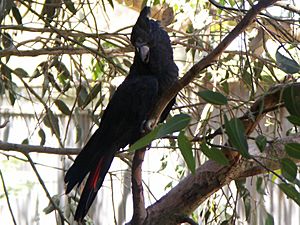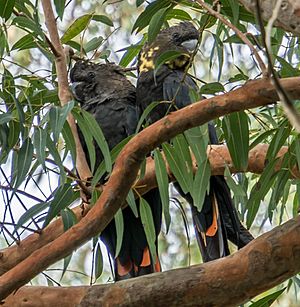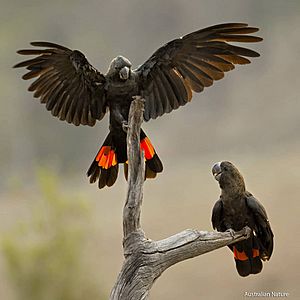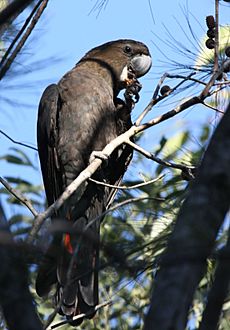Glossy black cockatoo facts for kids
Quick facts for kids Glossy black cockatoo |
|
|---|---|
 |
|
| C. l. halmaturinus on Kangaroo Island | |
| Conservation status | |
| Scientific classification | |
| Genus: |
Calyptorhynchus
|
| Species: |
lathami
|
| Subspecies | |
|
C. (C.) l. lathami |
|
 |
|
| Glossy black cockatoo range (in red) | |
The glossy black cockatoo (Calyptorhynchus lathami) is a special type of cockatoo found in eastern Australia. It is the smallest black cockatoo. These birds can grow to about 50 centimeters (20 inches) long.
Male and female glossy black cockatoos look different. This is called sexual dimorphism. Males are mostly blackish-brown with bright red bands on their tails. Females are a duller brownish color with some yellow spots. There are three main types, or subspecies, of this cockatoo.
Contents
Understanding Glossy Black Cockatoo Taxonomy
The glossy black cockatoo was first described by a Dutch scientist named Coenraad Jacob Temminck in 1807. Its scientific name, lathami, honors an English bird expert, John Latham.
This cockatoo's closest relative is the red-tailed black cockatoo. These two birds are grouped together in a special family of black cockatoos. They are different from other black cockatoos because males and females look quite distinct. Also, their young birds make unique sounds when they are hungry or eating.
Glossy Black Cockatoo Subspecies
Scientists have identified three different subspecies of the glossy black cockatoo. These groups are very similar, but they live in different areas.
- Eastern Glossy Black Cockatoo (C. l. lathami): This subspecies is rare. It lives in eastern Australia, from Queensland down to Victoria. You can find it in areas with casuarina trees.
- Central Queensland Glossy Black Cockatoo (C. l. erebus): This type lives in central Queensland, from Mackay south to Gympie.
- Kangaroo Island Glossy Black Cockatoo (C. l. halmaturinus): This subspecies is found only on Kangaroo Island in Australia. It is listed as endangered by the Australian Government. At one point, there were only about 158 of these birds left. Thanks to conservation efforts, their numbers grew to about 370 by 2019.
Kangaroo Island Cockatoo's Diet
The Kangaroo Island cockatoo mainly eats seeds from the drooping she-oak (Allocasuarina verticillata) and the sugar gum (Eucalyptus cladocalyx) trees. They especially like the fresh cones from the drooping she-oak. They hold the cones with their feet and use their strong beaks to shred them. Then, they use their tongues to get the seeds out.
Protecting the Kangaroo Island Subspecies
In early 2020, large bushfires affected Kangaroo Island. These fires destroyed much of the drooping she-oak trees, which are the main food source for these cockatoos. Scientists were worried about the future of this subspecies. A lot of the island's area was burned. After the fires, experts began to assess the damage and plan for recovery.
There have been successful programs to protect this subspecies. One important effort was to stop common brushtail possums from eating the cockatoo's eggs and chicks.
Glossy Black Cockatoo Appearance
Like the red-tailed black cockatoo, the glossy black cockatoo shows sexual dimorphism. This means males and females look different.
The male glossy black cockatoo is mostly black. It has a chocolate-brown head and bright red patches on its tail. The female is a duller dark brown. She has yellow spots on her tail and around her neck. You can also tell them apart because the female's tail has bars, while the male's tail has solid patches.
Adult birds are usually between 46 and 50 centimeters (18 to 20 inches) long. These cockatoos live in open forests and woodlands. They mostly eat seeds from she-oak trees (Casuarina species).
Glossy Black Cockatoo Conservation Status
Most parrot species, including the glossy black cockatoo, are protected by an international agreement called CITES. This agreement helps control the trade of wild animals. The glossy black cockatoo is on CITES Appendix II, which means it's a vulnerable species. This makes it illegal to import, export, or trade these birds if they were caught in the wild.
While the glossy black cockatoo generally isn't listed as threatened across all of Australia, the Kangaroo Island subspecies (C. l. halmaturinis) is listed as endangered.
Conservation in Victoria, Australia
- The eastern subspecies (C. l. lathami) is listed as threatened in the state of Victoria. Plans are being developed to help this species recover and manage its future.
- On Victoria's 2007 list of threatened animals, C. l. lathami is listed as vulnerable.
Conservation in Queensland, Australia
In Queensland, the Environmental Protection Agency also lists C. l. lathami as vulnerable.
See also
 In Spanish: Cacatúa lustrosa para niños
In Spanish: Cacatúa lustrosa para niños






